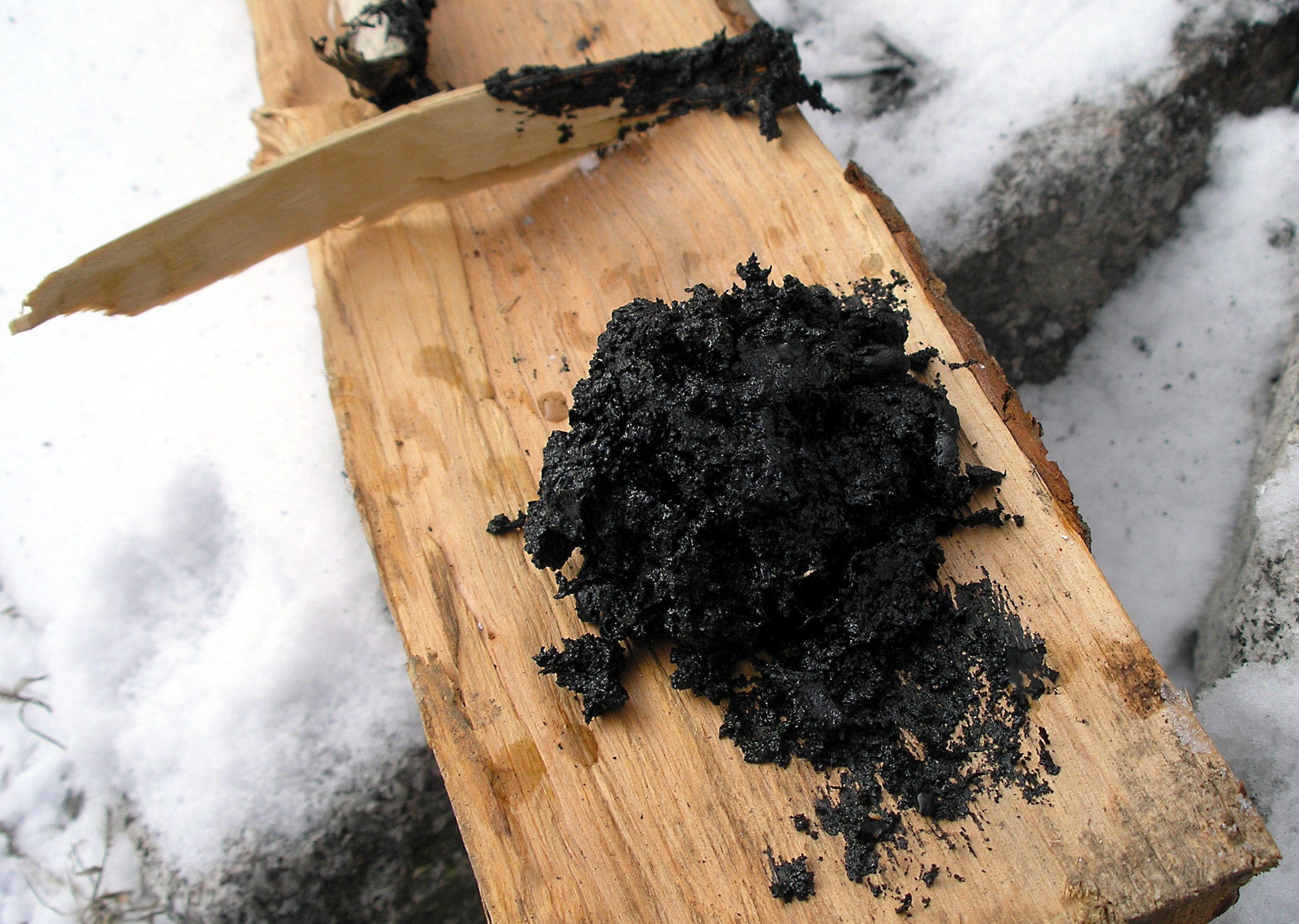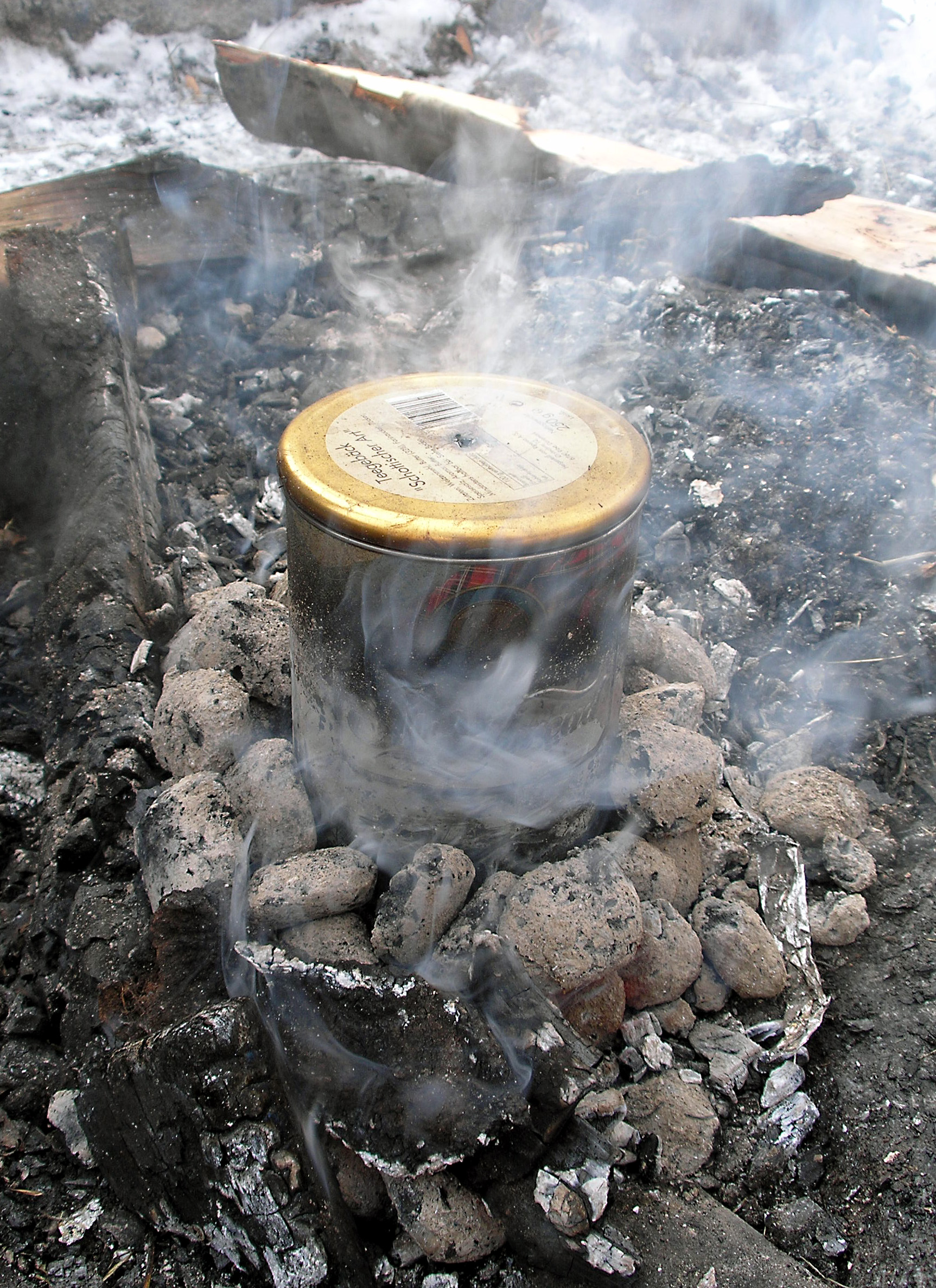Birch tar on:
[Wikipedia]
[Google]
[Amazon]
 Birch bark tar (sometimes referred to as birch bark pitch) is a substance that is synthesized by
Birch bark tar (sometimes referred to as birch bark pitch) is a substance that is synthesized by
 Birch bark tar use as an
Birch bark tar use as an  Birch bark tar is also one of the components of Vishnevsky liniment.
Birch bark tar oil is an effective repellent of
Birch bark tar is also one of the components of Vishnevsky liniment.
Birch bark tar oil is an effective repellent of
"Birch Tar Oil A Powerful Antiseptic"
''OtzisPouch'', 2020-04-01 owing to a large amount of phenol derivatives and terpenoid derivatives. Birch bark tar oil was used in the eighteenth century alongside
Non-video demonstrationTreating Leather With Birch Tar
{{Non-timber forest products Adhesives Non-timber forest products
dry distillation
Dry distillation is the heating of solid materials to produce gaseous products (which may condense into liquids or solids). The method may involve pyrolysis or thermolysis, or it may not (for instance, a simple mixture of ice and glass could be ...
of birch
A birch is a thin-leaved deciduous hardwood tree of the genus ''Betula'' (), in the family Betulaceae, which also includes alders, hazels, and hornbeams. It is closely related to the beech- oak family Fagaceae. The genus ''Betula'' contains 3 ...
tree bark.
Chemical composition
Birch bark tar is mainly composed oftriterpenoid
Triterpenes are a class of terpenes composed of six isoprene units with the molecular formula C30H48; they may also be thought of as consisting of three terpene units. Animals, plants and fungi all produce triterpenes, including squalene, the pre ...
compounds of the lupane and oleanane
Oleanane is a natural triterpenoid. It is commonly found in woody angiosperms and as a result is often used as an indicator of these plants in the fossil record. It is a member of the oleanoid series, which consists of pentacyclic triterpenoids ...
family, which can be used as biomarkers to identify birch bark tar in the archaeological record. The most characteristic molecules are betulin and lupeol, which are also present in birch bark. Some of these molecules degrade into other lupane and oleanane skeleton triperpenes. The most commonly found additional molecules are lupenone, betulone, lupa-2,20(29)-dien-28-ol, lupa-2,20(29)-diene and allobetulin.
Ancient and modern uses
 Birch bark tar use as an
Birch bark tar use as an adhesive
Adhesive, also known as glue, cement, mucilage, or paste, is any non-metallic substance applied to one or both surfaces of two separate items that binds them together and resists their separation.
The use of adhesives offers certain advantage ...
began in the Middle Paleolithic
The Paleolithic or Palaeolithic ( years ago) ( ), also called the Old Stone Age (), is a period in human prehistory that is distinguished by the original development of stone tools, and which represents almost the entire period of human prehist ...
. Neanderthals
Neanderthals ( ; ''Homo neanderthalensis'' or sometimes ''H. sapiens neanderthalensis'') are an extinction, extinct group of archaic humans who inhabited Europe and Western and Central Asia during the Middle Pleistocene, Middle to Late Plei ...
produced tar through dry distillation of birch bark as early as 200,000 years ago. A 2019 study demonstrated that birch bark tar production can be a simpler, more discoverable process by directly burning birch bark under overhanging stone surfaces in open-air conditions. However, at Königsaue (Germany), Neanderthals did not make tar with this method but rather employed a technically more demanding underground production method. A find from the Dutch North Sea and two tools from the Italian site Campitello show that Neanderthals used birch bark tar as a backing on small 'domestic' stone tools.
Birch bark tar also has been used as a disinfectant
A disinfectant is a chemical substance or compound used to inactivate or destroy microorganisms on inert surfaces. Disinfection does not necessarily kill all microorganisms, especially resistant bacterial spores; it is less effective than ...
, in leather
Leather is a strong, flexible and durable material obtained from the tanning (leather), tanning, or chemical treatment, of animal skins and hides to prevent decay. The most common leathers come from cattle, sheep, goats, equine animals, buffal ...
dressing, and in medicine.
A piece of 5,000-year-old chewing gum
Chewing gum is a soft, cohesive substance designed to be chewed without being swallowed. Modern chewing gum is composed of gum base, sweeteners, softeners/plasticizers, flavors, colors, and, typically, a hard or powdered polyol coating. Its tex ...
made from birch bark tar, and still bearing tooth imprints, was found in Kierikki, Finland. Genetic material left in the gum enabled novel research to identify population movements, types of food consumed, and types of oral bacteria found on their teeth.
A different chewing gum sample, dated to 5,700 years old, was found in southern Denmark
Denmark is a Nordic countries, Nordic country in Northern Europe. It is the metropole and most populous constituent of the Kingdom of Denmark,, . also known as the Danish Realm, a constitutionally unitary state that includes the Autonomous a ...
. A complete human genome
The human genome is a complete set of nucleic acid sequences for humans, encoded as the DNA within each of the 23 distinct chromosomes in the cell nucleus. A small DNA molecule is found within individual Mitochondrial DNA, mitochondria. These ar ...
and oral microbiome
A microbiome () is the community of microorganisms that can usually be found living together in any given habitat. It was defined more precisely in 1988 by Whipps ''et al.'' as "a characteristic microbial community occupying a reasonably wel ...
was sequenced from chewed birch bark tar. Researchers identified that the individual who chewed the gum was a female who was closely related genetically to hunter-gatherer
A hunter-gatherer or forager is a human living in a community, or according to an ancestrally derived Lifestyle, lifestyle, in which most or all food is obtained by foraging, that is, by gathering food from local naturally occurring sources, esp ...
s from mainland Europe.
Fletching
Fletching is the fin-shaped aerodynamic stabilization device attached on arrows, crossbow bolts, Dart (missile), darts, and javelins, typically made from light semi-flexible materials such as feathers or Bark (botany), bark. Each piece of such a ...
on arrow
An arrow is a fin-stabilized projectile launched by a bow. A typical arrow usually consists of a long, stiff, straight shaft with a weighty (and usually sharp and pointed) arrowhead attached to the front end, multiple fin-like stabilizers c ...
s were fastened with birch bark tar, and rawhide lashing and birch bark tar were used to fix axe
An axe (; sometimes spelled ax in American English; American and British English spelling differences#Miscellaneous spelling differences, see spelling differences) is an implement that has been used for thousands of years to shape, split, a ...
blades in the Mesolithic period.
Birch bark tar was more frequently discovered in archaeological contexts dating from the Neolithic
The Neolithic or New Stone Age (from Ancient Greek, Greek 'new' and 'stone') is an archaeological period, the final division of the Stone Age in Mesopotamia, Asia, Europe and Africa (c. 10,000 BCE to c. 2,000 BCE). It saw the Neolithic Revo ...
to the Iron Age
The Iron Age () is the final epoch of the three historical Metal Ages, after the Chalcolithic and Bronze Age. It has also been considered as the final age of the three-age division starting with prehistory (before recorded history) and progre ...
. For example, birch bark tar was identified to serve as an adhesive to repair and decorate/paint ceramic vessels, as a sealing/waterproofing agent. A well-known example of birch bark tar hafting
Hafting is a process by which an Artifact (archaeology), artifact, often made of bone tool, bone, stone tool, stone, or tool steel, metal is attached to a ''haft'' (handle or strap). This makes the artifact more useful by allowing it to be launch ...
during the copper age is Ötzi’s hafted arrow points and copper axe. Multiple discoveries show that birch bark tar was also used to assemble metal artefacts, such as pendants and other ornaments, on both a functional and decorative level. During the Roman Era
In modern historiography, ancient Rome is the Roman people, Roman civilisation from the founding of Rome, founding of the Italian city of Rome in the 8th century BC to the Fall of the Western Roman Empire, collapse of the Western Roman Em ...
, birch bark tar is mostly replaced by wood tar, but birch bark tar is still used, for example, to decorate hinges and other bone objects.
Russia leather is a water-resistant leather, oiled with birch bark oil after tanning. This leather was a major export good from seventeenth- and eighteenth-century Russia, as the availability of birch bark oil limited its geographical production. The oil impregnation also deterred insect attack and gave a distinctive and pleasant aroma that was seen as a mark of quality in leather.gastropod
Gastropods (), commonly known as slugs and snails, belong to a large Taxonomy (biology), taxonomic class of invertebrates within the phylum Mollusca called Gastropoda ().
This class comprises snails and slugs from saltwater, freshwater, and fro ...
s. The repellent effect lasts about two weeks. The repellent effect of birch bark tar oil mixed with petroleum jelly
Petroleum jelly, petrolatum (), white petrolatum, soft paraffin, or multi-hydrocarbon, CAS number 8009-03-8, is a semi-solid mixture of hydrocarbons (with carbon numbers mainly higher than 25), originally promoted as a topical ointment for i ...
and applied to a fence can last up to several months.
Birch bark tar oil has strong antiseptic properties,Wanamaker, L"Birch Tar Oil A Powerful Antiseptic"
''OtzisPouch'', 2020-04-01 owing to a large amount of phenol derivatives and terpenoid derivatives. Birch bark tar oil was used in the eighteenth century alongside
civet
A civet () is a small, lean, mostly nocturnal mammal native to tropical Asia and Africa, especially the tropical forests. The term ''civet'' applies to over a dozen different species, mostly from the family Viverridae. Most of the species's div ...
and castoreum
Castoreum is a yellowish exudate from the castor sacs of mature beavers used in combination with urine to territorial marking, scent mark their territory.
Both beaver sexes have a pair of castor sacs and a pair of anal glands, located in two c ...
and many other aromatic substances to scent the fine Spanish leather Peau d'Espagne. At the turn of the twentieth century, birch bark tar had become a specialty fragrance material in perfumery as a base note to impart a leathery, smoky note in fragrances, especially from the leather and tobacco genre, and to a lesser extent in Chypres, especially Cuir de Russie
Cuir de Russie () is a fragrance from Parisian couturier Gabrielle "Coco" Chanel. (The term may also refer to other Russia leather perfumes, most notably ''Creed Cuir de Russie''.)
History
Coco Chanel had worked with Ernest Beaux on her origi ...
perfumes and fragrance bases, typically together with castoreum and isobutyl quinoline. It is used as an ingredient in some soaps, i.e. the scent of Imperial Leather soap, though other tars (i.e. from pine, coal) with an equally phenolic and smoky odour are more commonly used in soaps as a medicating agent.
References
External links
Non-video demonstration
{{Non-timber forest products Adhesives Non-timber forest products